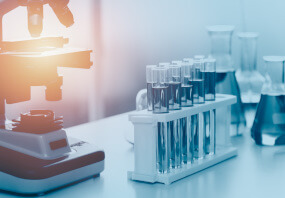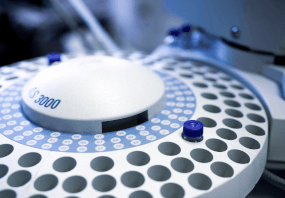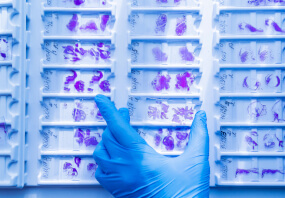General description
Sodium/hydrogen exchanger 3 (UniProt: Q28362; also known as Na(+)/H(+) exchanger 3, NHE-3, Solute carrier family 9 member 3) is encoded by the SLC9A3 (also known as NHE3) gene in Didelphis virginiana (North American opossum). NHE-3 is a multi-pass membrane protein that is involved in pH regulation to eliminate acids generated by active metabolism or to counter adverse environmental conditions. NHE-3 is predominantly expressed in kidney and gut, where it is found on the apical membranes of polarized epithelial cells and plays a central role in transepithelial reabsorption of sodium ions and secretion of hydrogen ions. Renal NHE-3 is essential in maintaining blood pressure and steady-state plasma sodium levels when dietary sodium chloride intake is modified. In the intestine epithelial cells, it localizes to the ileal brush border. Dysfunction of NHE-3 in intestine is associated with a variety of diarrheal diseases. HNE-3 can be phosphorylated by SGK1 at Ser669 that increases its abundance at the cell membrane. (Ref.: D Souza, S et al. (1998). J. Biol. Chem. 273(4); 2035 2043; Fenton, RA et al (2017). Kidney Int. doi: 10.1016/j.kint.2017.02.001. [Epub ahead of print]).
Specificity
Clone CH3 detects Sodium/hydrogen exchanger 3 in human, opossum, and rat kidney cells. It targets an epitope within 356 amino acids from the C-terminal half.
Immunogen
MBP-conjugated recombinant fragment corresponding to 356 amino acids from the C-terminal half of Opossum sodium/hydrogen exchanger 3.
Application
Anti-NHE3, clone 3H3, Cat. No. MABN1813, is a highly specific mouse monoclonal antibody that targets Sodium/hydrogen exchanger 3 and has been tested for use in Immunohistochemistry, Immunoprecipitation, and Western Blotting.
Immunohistochemistry Analysis: A 1:50 dilution from a representative lot detected NHE3 in human kidney and human stomach tissue sections.
Western Blotting Analysis: A representative lot detected NHE3 in Western Blotting applications (Wang, D., et. al. (2006). Am J Physiol Renal Physiol. 290(2):F428-37; Queiroz-Leite, G.D., et. al. (2011). Biochem Biophys Res Commun. 409(3):470-6; Goyal, S., et. al. (2005). Am J Physiol Renal Physiol. 288(3):F530-8; Kocinsky, H.S., et. al. (2005). Am J Physiol Renal Physiol. 289(2):F249-58; Di Sole, F., et. al. (2008). J Cell Physiol. 216(1):221-33; Baum, M., et. al. (2012). Am J Physiol Renal Physiol. 303(11):F1495-502; Lessa, L.M., et. al. (2012). Am J Physiol Renal Physiol. 303(10):F1399-408).
Immunohistochemistry Analysis: A representative lot detected NHE3 in Immunohistochemistry applications (Pao, A.C., et. al. (2010). Am J Physiol Renal Physiol. 299(6):F1496-506).
Immunoprecipitation Analysis: A representative lot detected NHE3 in Immunoprecipitation applications (Girardi, A.C., et. al. (2004). Am J Physiol Renal Physiol. 287(5):C1238-45).
Research Category
Neuroscience
Quality
Evaluated by Western Blotting in COS-7 cells transfected with wild type NHE3 plasmid DNA.
Western Blotting Analysis: 0.25 µg/mL of this antibody detected NHE3 in lysates from COS-7 cells transfected with wild type NHE3 plasmid DNA.
Target description
~75 kDa observed; 94.77 kDa calculated. Uncharacterized bands may be observed in some lysate(s).
Physical form
Format: Purified
Protein G purified
Purified mouse monoclonal antibody IgG1 in buffer containing 0.1 M Tris-Glycine (pH 7.4), 150 mM NaCl with 0.05% sodium azide.
Storage and Stability
Stable for 1 year at 2-8°C from date of receipt.
Other Notes
Concentration: Please refer to lot specific datasheet.
Disclaimer
Unless otherwise stated in our catalog or other company documentation accompanying the product(s), our products are intended for research use only and are not to be used for any other purpose, which includes but is not limited to, unauthorized commercial uses, in vitro diagnostic uses, ex vivo or in vivo therapeutic uses or any type of consumption or application to humans or animals.
- UPC:
- 51172480
- Condition:
- New
- Availability:
- 3-5 Days
- Weight:
- 1.00 Ounces
- HazmatClass:
- No
- MPN:
- MABN1813












